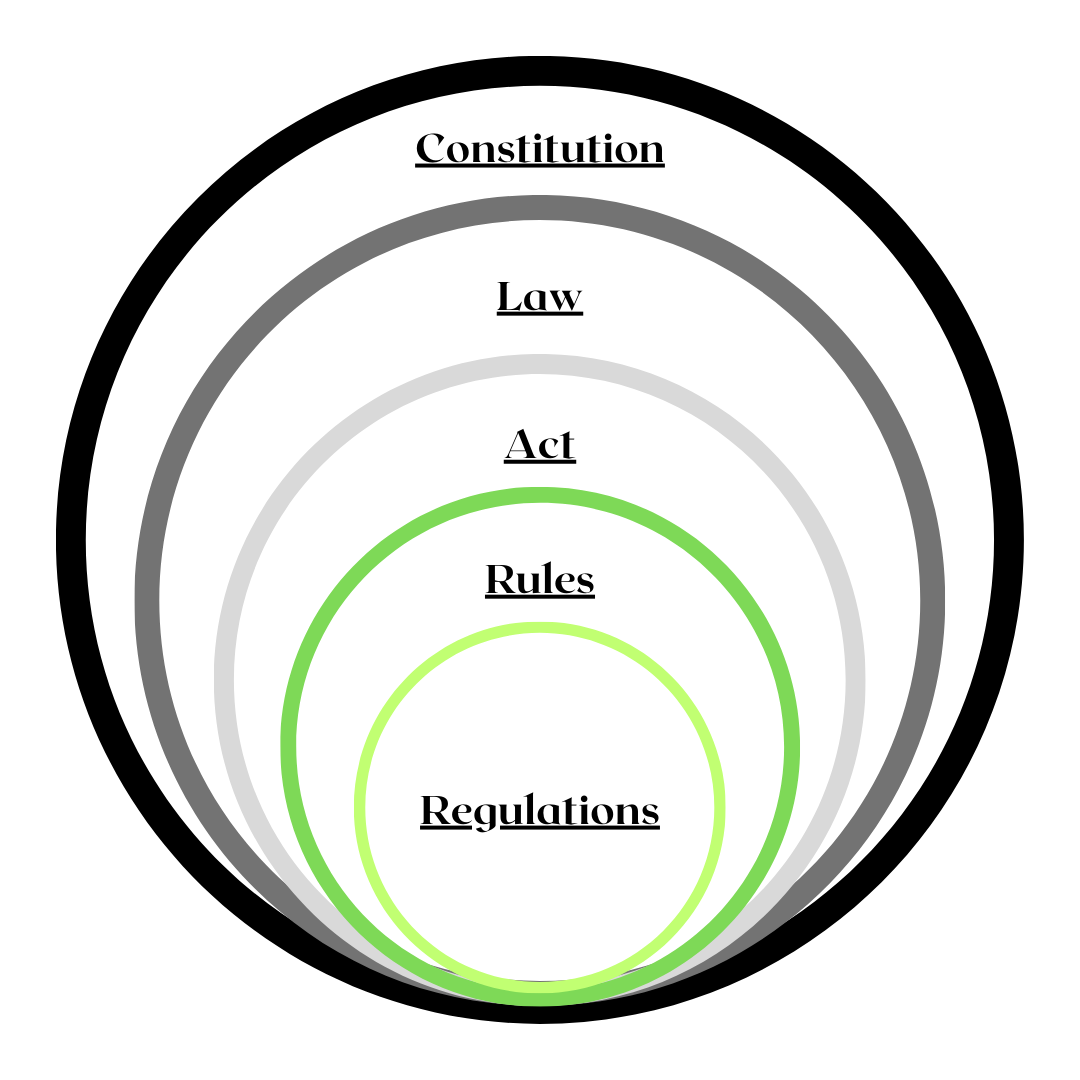Currently Empty: ₹0.00
Demystifying Legal Terminology in the Food Industry
A Food Law and Regulation Primer
Can you point out the difference between the Food Safety and Standards Rules, 2011 and the Food Safety Regulations which are published periodically? Do these legal instruments stand on a different pedestal when compared to the Food Safety and Standards Act, of 2006? The confusion that persists in this area compels us to ask elementary questions like – What is a ‘Rule’? How do you define a ‘Regulation’? A Bill, An Act, A Notification, An Advisory? To be completely honest, the distinctions between these instruments remain largely blurry and are considered rather irrelevant, especially in the working of the law, as it has very minimal or absolutely no influence on its practicality.
Nevertheless, being a stickler for proper use/placement of terms, this Article attempts to make the best possible definition and distinction between the aforementioned terminology. We must start by understanding what a Bill means, as without a Bill – in a general circumstance (the exception being an Ordinance passed by the President in the Parliament) – there can be no Act, and therefore no Rules and usually no Regulations. A Bill is essentially the draft of legislation introduced and subsequently passed by both Houses of Parliament, i.e., the Lok Sabha and Rajya Sabha, in accordance with Article 107 of the Constitution of India. To put this in the context of the food industry, we recognise that the Food Safety and Standards Bill, 2005 was first introduced in the same year (August 25, 2005) before the lower house, i.e., the Lok Sabha or the House of People of the Parliament. This Bill was then referred to a Standing Committee five days after its introduction (August 30, 2005) for additional recommendation and scrutiny of the Bill. The Standing Committee subsequently submitted its report (February 21, 2006) before the Houses. Subsequently and evidently, this Bill was passed by the Lok Sabha (July 26, 2006) and the Rajya Sabha (August 02, 2006). It must be noted that until this stage of the legislative process, the Food Safety and Standards Bill 2005 still remained a Bill.
After being passed by both Houses of Parliament, only one factor can convert a Bill into an ‘ACT’ – the assent of the President of India. Returning to the storyline, the assent of the President of India, Dr. A.P.J. Abdul Kalam at the time, to the Food Safety and Standards Bill, 2005 passed by the Houses, culminated in the formulation of the Food Safety and Standards Act, 2006. Therefore, it would be right to say that for a Central Act to come into play, it must be passed by both Houses of Parliament and receive assent from the President in accordance with Article 111 of the Indian Constitution.
The same process is triggered to bring a State Act into force. The Bill is introduced before either House and must be passed by the State Legislative Assembly and the State Legislative Council according to Article 196 of the Constitution of India. In place of the President, at the State level, every Bill requires the assent of the Governor and hence an Act applicable to that particular State will come into force. However, we must be wary of the fact that the mere existence of an Act (either State or Central) does not necessarily imply its enactment/enforcement. The means and methods of its enactment will be addressed as we go in this Article.
An Act/Legislation/Statute lays down the basic framework capturing the larger issues in the area. For example, the Food Safety and Standards Act, 2006 (Hereinafter referred to as “FSSA”) as the Act itself reads in the Preamble, “An Act to consolidate the laws relating to food and to establish the Food Safety and Standards Authority of India for laying down science-based standards for articles of food and to regulate their manufacture, storage, distribution, sale and import, to ensure availability of safe and wholesome food for human consumption and for matters connected therewith or incidental thereto.” The Act can be seen as the skeleton addressing certain prominently identified issues. However, in nine cases out of ten, the legislature (The Parliament/State Assemblies) is too overburdened, too busy and/or lacks the expertise to define the nuances of the Act, i.e., it fails to legislate upon HOW the Act is to be implemented. Most times, the legislature goes as far as leaving intentional gaps in the legislature to be filled by someone else.
Who is this someone else, and what do they do?
At this stage, the legislature delegates/shares its legislative power upon the executive agency of the country, which is – the Central Government and the State Government respectively. The executive authorities derive this power from the relevant Act to draft ‘RULES’, which essentially forms flesh and blood of the skeleton. This delegation of power, for reasons other than those mentioned above, also takes place for the sake of convenience and ease of amendment because of their inherent nature. Rules lay out minute details with regard to the implementation of the Statute in a more practical and dynamic society. They ideally fill up the gaps of the legislature to allow the smooth functioning of the Act to attain its objectives. An Act, therefore, would be meaningless without the sole support of Rules. This has been gorgeously laid out within the FSSA and is presented herein for contextual clarity.
The FSSAI addresses the aspect of Rules under Chapter XII titled Miscellaneous. Sections 91 and 94 of the Act empower the Central and State Governments respectively, to make Rules on the certain subject matter as mentioned within the provision. Here, it is to be noted, that each of these executive bodies have only that much power as assigned by the Act and cannot legislate on any issue beyond what is mentioned under their respective Sections. Therefore, Rules can be viewed as the wheels to the Act, the means to make it move.
You may now say – Okay, I understand what Rules are…but what in this gigantic universe are Regulations?
What is the point of Regulations when there are Rules?
WHY Regulations?
I hope this Article rids you of your frustration. Here we go.
Regulations are, you can say, a form of Rules passed not by either Government but rather by a Statutory Body. A statutory/regulatory body is one that is set up through a Statute and a prime example of the same would be the widely known Food Safety and Standards Authority of India. This has been established via Chapter II, Section 4 of the FSSA (a statute) and hence, is considered as a statutory body. Now, Regulations (as passed by the body authorized under the statute), just as in the case of Rules, derive their power from the Act itself which can be seen under Section 92 of the FSSA titled “Power of Food Authority to make regulations”. However, unlike Rules, Regulations are more area specific and rather flexible, implemented to deal with an immediate or more dynamic issue in question. These are usually formulated on a more real-time basis. In one sense, it would not be impossible for an Act to come into effect in the absence of Regulations (unlike Rules). Nonetheless, it must be kept in mind that Rules and Regulations don’t differ plenty in terms of their functionality.
While discussing the terms Act, Rules and Regulations, it would be grossly wrong to keep mum from informing you about intra vires Principle. The FSSAI, through Section 93, partially reflects the Principle of intra vires by stating that every rule and every regulation made as per the powers conferred by the Act is required to be tabled before both Houses of Parliament for the purposes of modification. Since the Parliament is the delegating authority, it becomes the prerogative of the Parliament to review the rules and regulations and further make sure that such rules and regulations were “within the powers” of the body doing so as well as within the scope of the Parent Act, hence applying the Principle of intra vires.
To further clarify, it must be noted that Rules and Regulations are usually formulated on different subject matters. Here is an example. The FSSAI designates various persons in important positions, such as the Food Safety Commissioner, the Food Safety Officer as well as the Food Anlalyst, but remains restricted to empowering their presence and stating their Duties as per the law. Rules facilitate and allow the implementation of each of these positions by laying down further powers and duties and the qualifications and procedure for appointment. On the other hand, Regulations being more specific, for example, Food Safety and Standards (Food Recall Procedure) Regulation, 2017 builds upon Section 28 of the FSSA to lay down the entire scope and procedure of recall under Chapters III and IV of the Regulations.
We are now at the juncture where – the Legislature has formulated an Act, the relevant executive authority has made rules, and the statutory body has drafted a set of Regulations. How do people like YOU&ME know that such legal instruments exist, considering that these have the humongous capability to adversely affect our businesses directly or indirectly when not brought to our knowledge? This is the main and primary function of a notification – to notify – to bring to your notice and to inform. A notification is the means and method of implementation and publication of any Act, Rule or Regulation. For example, Section 1(3) of the FSSA clearly states that the Act “shall come into force on such date as the Central Government may, by notification in the Official Gazette, appoint, and different dates may be appointed for different provisions of this Act and any reference in any such provision to the commencement of this Act shall be construed as a reference to the coming into force of that provision.” When such a publication is made in the Official Gazette, it is presumed that every individual is aware and has knowledge of the content of these publications – which therefore rules out the possibility of pleading ignorance of the law. On the other hand, an advisory is merely a recommendation, guideline or suggestion by an authority to possibly go about a certain activity in a designated manner.
Am I bound by all of these Legal Instruments?
No. At the outset, it is absolutely necessary to understand that Advisories are simply for the sake of advice and guidance, and are not binding on any individual, enterprise or Food Business Operator. However, as per Article 13(3)(a) which defines the “law” as follows, ““law” includes any Ordinance, order, bye-law, rule, regulation, notification, custom or usage having in the territory of India the force of law” includes within its ambit rules, regulations and notifications. The term “laws in force” under Article 13(3)(b) includes all laws that are passed by the legislature in the territory of India. And thus, despite the subtle difference among them, Acts, Rules, Regulations and Notifications are all equally legally binding and must be adhered to as under the banner of the “law of the land”.

| Bill | Act | Rule | Regulation | Notification |
| Draft Legislation introduced/presented before either House of Parliament (Lok Sabha and Rajya Sabha)/State Legislature (Legislative Assembly and Legislative Council). | Bill passed by both Houses of Parliament/State Legislature and assented to/signed by the President/Governor of India respectively. | The flesh and blood of an Act to allow for its implementation. | Further guidelines laid down in consonance with the Act on more specific areas. | A form/means of publication of an Act/Rules/Regulations. |
| Supreme Legislation | Subordinate/Delegated Legislation | Subordinate/Delegated Legislation. | ||
| Supreme Legislation | Subordinate to the Act. In the legal field, considered to have less sanctity compared to an Act. | Subordinate to Rules. In the legal field, considered to have less sanctity compared to Rules. | ||
| Drafted and passed by the legislature. | Drafted by the Executive and tabled before the legislature for any modifications | Usually drafted by a Statutory Body or Organisation and tabled before the legislature for modifications, if required to do so. | ||
| Food Safety and Standards Bill, 2005 | Food Safety and Standards Act, 2006 | Chapter XII of the FSSA – Sections 91 and 94 of the Act empower the Executive to formulate Rules by the Centre and the State respectively. A product of this is the Food Safety and Standards Rules, 2011. | Section 92 of the FSSA empowers the FSSAI to formulate Regulations. The most recent example of such Regulations is the Food Safety and Standards Authority of India (Financial) Regulations, 2023. | Each and every such Act, Rule or Regulation has been notified in the Official Gazette of India. |
*LAW: Article 13(3)a and 13(3)(b) of the Indian Constitution. Act, Rule , Regulation and Notifications are different aspects of a Law.
*FSSAI – Full Form – Food Safety and Standards Authority of India
Established under the Food Safety And Standards Act, 2006







